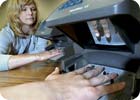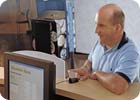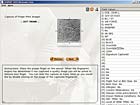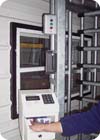
Biometrics-based readers can provide a diversity of
applications from physical access control and identification
to time and attendance.
Security industry reporters have been writing about “this is the year of biometrics” for about 15 years. But, according to Security Magazine research and experts in the field, biometrics may finally have emerged – or not.
For example, the silicon chip fingerprint sensor market, swipe and area sensors, lies in applications different to those of optical sensors. The last 12 months have seen a flurry of activity in this market. It is believed that silicon chip sensors have finally come of age. Silicon fingerprint participants have carved their niche in wireless applications and are making considerable in-roads in the network security application. Demand has predominantly been for swipe sensors in fingerprint-enabled cell phones, laptops and notebooks. Frost & Sullivan, the international research firm, believes growth lies with swipe sensors.
This includes the integration of sensors in silicon fingerprint-enabled cell phones for the wireless market and for laptops and notebooks in the PC/network security market. In the physical access control market, fingerprint-enabled door locks are expected to have an impact. The initial offering of silicon fingerprint sensors has been positioned as a convenience solution both in the wireless and network security markets. It is expected that phase two will result in application focused security solutions.

Many biometrics-based systems has simplified enrollment
so as to encourage more people to sign up.
DIFFERENT REQUIREMENTS
Within wireless and network security, price, size and durability are key priorities. However, within the physical access control market accuracy, performance, product durability and reference sites take precedence, according to Frost & Sullivan.Without a doubt, there are standards being set for biometrics. Last month, the National Biometric Security Project (NBSP) published the Biometric Technology Application Manual (BTAM), a comprehensive reference manual on biometric technology applications. This reference work, in two volumes, has been compiled for biometric technology users and for those who are evaluating the integration of biometrics into new or existing security systems. The BTAM is intended to be a rational and practical tool for those who specify, buy, integrate, operate, and manage biometric technology-based systems.
According to John E. Siedlarz, NBSP chairman and CEO, “With the expanded deployment of biometric technologies to achieve greater identity assurance the need for an authoritative and regularly updated reference and database on virtually all aspects of biometrics is a pressing requirement.”
NBSP is a not-for-profit test, research and analysis organization focused on the application of biometrics to improve the security of the U.S. civil infrastructure.
There are additional introductions centering on business use of biometrics.
A new biometric security solution from Diebold, for instance, increases consumer and financial institution protection against identity theft and fraud by verifying account holders’ identities by their unique fingerprint profile.
Called identiCenter, and powered by US Biometrics, it’s an integrated system for identity verification and branch traffic management built around fingerprint-reading hardware and software. It’s designed to quickly, accurately and securely identify consumers who enter a financial institution and increase efficiencies within the branch.
Dennis Moriarty of Diebold Global Security said they are working with financial institutions to transform branch operations to meet the needs of tomorrow’s retail banking consumer by streamlining operations, personalizing customer service and enabling faster, more secure transactions.
In many applications, biometrics fights identity fraud.
The Federal Trade Commission reported that 10 million Americans were victims of identity theft in 2002, the most updated numbers available, with a total cost impact of $50 billion annually. In addition, the fraudulent use of victims’ personal information to obtain goods and services cost businesses and financial institutions $33 billion in 2002.
At the same time, industry research shows that more than half of American consumers say a bank branch is their preferred mode of interaction with their financial institution. Further, according to Accenture, 42 percent of consumers visit their branch at least once per week and 86 percent visit at least once per month.
“In a world where PINs, bank cards, Social Security numbers and account numbers too often fall into the wrong hands, biometrics can reduce fraudulent transactions, minimize losses from fraud and increase consumer confidence by verifying consumers’ identities using their own unique biometric information,” said Brad Stephenson, vice president of Diebold’s Physical Security Group.
LINKING DATABASES
At its basic level, identiCenter links an individual’s identity and account information to his or her unique fingerprint profile. Upon initiating a transaction at the teller station, enrolled consumers place their finger on an optical-scan fingerprint reader to verify their identity. Once verified, their account information automatically appears on the teller’s screen.Some biometric-enabled devices aim at more traditional physical access control needs.
AuthenTec, for example, has sensors designed into a wide range of access control devices, including multiple biometric door locks, smart cards, remote RF entry keys, time and attendance readers and other devices. Its TruePrint technology creates solutions specifically tailored for access control devices.
Then there are military applications for biometrics.
One example: The U.S. military is using Schlage Recognition Systems hand geometry readers housed inside a custom portal to ensure only authorized individuals access base camps in the Middle East. Handreaders automatically take a three-dimensional reading of the size and shape of a hand and verify the user’s identity in less than one second. They are not affected by dust, dirty hands, and minor injuries, which can cause false rejects with other biometric technology.
“The military used the hand geometry readers as a beta test in the theater for nine months and had excellent results,” says David Slagel, president of Modular Security Systems, the integrator from Ironton, Ohio. “They specifically requested the HandKey model because of its reliability, accuracy and durability. The HandKey unit is then placed inside our proprietary Modular Access Control (MAC) portal, which provides turnstiles and an access control infrastructure.”
The resulting portable, turnkey access control portals are plug-and-play, fully integrated security systems planned for military bases throughout the world. To install a MAC portal, military personnel simply set it in place and plug it into 220-power in a junction box. Since the units are portable, the military can establish a “moving perimeter,” widely used in base construction.
“When they finish with one site, they can simply pick up the portal and move it to the next site,” Slagel emphasizes. “For the military, it represents zero construction process. They used to spend $80,000 to $100,000 rebuilding these ‘brass shacks’ each time the perimeter changed.”
Using the portals is also easy. Military personnel enter the portal through one of five roll-up doors. They walk up to the entrance and present a proximity card and then their hand to the Handreader. If the light turns green, they are allowed entrance through the turnstiles. If the light is red, an alarm is sounded that alerts a guard, who then investigates.

Government and military end-users are high on
biometrics.
MILITARY USES
Another firm, Sense Holdings, received multiple new orders from the United States Army for its proprietary biometric identification solution ISO-TRACK. The U.S. Army purchased Sense’s ISO TRACK security solution to strength security at a military facility based in Fort Carson, Colorado. Sense combined its DTU-100 biometric fingerprint reader, signature recognition pad USB digital camera, and the company’s custom ISO-TRACK software.
Financial institutions and other retail operations now
see biometrics as a way to combine security and convenience
for their customers.
SIDEBAR 1
Major Participants
The major market participants within this market are:- AuthenTec
- Atmel Corporation
- Fujitsu Microelectronics America
- Sony
- Silex
- UPEK Inc.
- Validity Sensors Inc.
- Veridicom
SIDEBAR 2
Business Drivers
Network Security Usage is Spurring Demand for Swipe Sensors- Adoption of Silicon Fingerprint-Enabled Cell Phones is Driving Demand for Swipe Sensors
- Lower Prices of Swipe Sensors Steering Uptake
- Fingerprint Evaluation Platforms Verifying Performance Levels
- Navigational and Personalization Features Boost Demand
- Development of USBs is Encouraging Market Growth
- Some of the market restraints are as follows:
- Credibility of Technology Performance Levels
- Stiff Competition from Alternative Technologies
- Some of the industry challenges are as follows:
- Cell Phone Market is Price Sensitive
- On-going Requirement for High Investments in Technological Development
- Key Partnerships and Alliances Critical to Success
- Inaccurate Supplier Claims Likely to Cause Customer Confusion Delaying Projects
- Real-world Performance and Strategic Reference Sites is Expected to Determine the Adoption of Biometric Systems
- Essential Training in Use of Fingerprint Technologies
